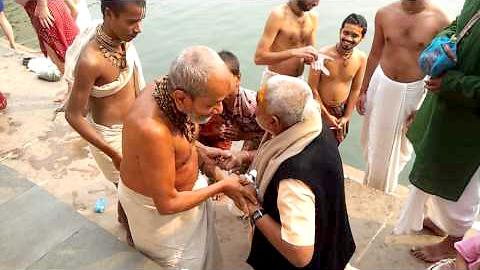
Bābājīs, Sahajiyās and Apasampradāyas
By Satyanarayana Dasa
Recently an article entitled “Disobedience and Deviation is More Dangerous than a Falldown!” by Mahasrnga Dasa was published on the Sampradaya Sun website (http://www.harekrsna.com/sun/editorials/08-13/editorials10510.htm) and brought to my notice. This article warns ISKCON devotees against associating with the bābājīs in Vraja, specifically Vrindavan and Rādhākuṇḍa. It criticizes bābājīs in general and me specifically, which I can tolerate. However the article goes on to debase my guru and our whole lineage which makes it my duty to clarify things and explain what the word bābājī really means.
It is clear that the general understanding within the Gauḍīya Maṭha (GM) and all of its branches like ISKCON is that bābājīs are people who pose as sādhus and enjoy women, at least two or three of them as quoted in this article, and that these bābājīs have nothing to do with spirituality or devotion to Krsna. I heard such descriptions of bābājīs hundreds of times while I was a member of ISKCON. Naively, I also used to believe that. However, the fact is that “bābājī” is a word of honor used to address a renounced sādhu in general and specifically in the Gauḍīya Vaiṣṇava sampradāya.
There are two types of renounced sādhus in India who are called sannyāsīs and vairāgīs. Sannyāsīs wear saffron dress, are usually addressed as ‘Swami’, and are followers of impersonal philosophy. Vairāgīs, however, wear white cloth and are addressed as bābājīs. The renounced Vaiṣṇavas in the line of Śrī Caitanya Mahāprabhu, Rāmānanda, Nimbarka and others come within this category. Śrī Caitanya-caritāmṛta mentions two vairāgīs who came with Mādhavendra Purī from Bengal (Madh 4.103) Haridāsa Ṭhākura is also called a vairāgī by the author Kṛṣṇadāsa Kavirāja Gosvāmī (Ant 3.103). Although Caitanya Mahāprabhu Himself was a sannyāsī and wore saffron, He propagated the white vairāgī dress for His renounced followers.
The reason for this is that scriptures forbid a Vaiṣṇava to wear kaṣāya, (saffron), red and blue dress, especially while doing deity worship. Some of these verses are culled in Haribhakti-vilāsa by Sanātana Gosvāmī. There it is said, nagno rakta paṭaḥ (4.147) – “For a Vaiṣṇava, wearing reddish cloth is like being naked” and, śukla-vāso bhaven nityaṁ raktaṁ caiva vivarjayet (4.152) – “The Vaiṣṇava should always wear white cloth and give up red cloth.”
In Śrī Caitanya-caritāmṛta, we find also the story of Jagadānanda Paṇḍita becoming upset with Sanātana Gosvāmī who was wearing a saffron cloth tied around his head that was not the prasad of Mahāprabhu. In humility, Sanātana Gosvāmī replied to Jagadānanda Paṇḍita saying: “This saffron cloth is unfit for a Vaiṣṇava to wear; therefore I have no use for it. I shall give it to a stranger.” (BBT CC Ant 13.60)
The ceremony of accepting the white cloth of a renunciant is generally called taking veśa (lit. dress). In Bengal it is called bheka. “Bābājī” is an honorable word for such renounced people which means grandfather in Hindi as well as in Vraja-bhasa, the language spoken in the Vraja area. It is also a general term used respectfully for sādhus all over India, e.g.: Mahāvatara Bābājī, Haidakhan Bābājī.
From this it should be known that the Six Gosvāmīs of the Gauḍīya sampradāya and others such as Viśvanātha Cakravartī Ṭhākura, Baladeva Vidyābhūṣana, Jagannātha dāsa Bābājī and Gaurakiśora dāsa Bābājī were all vairāgīs who wore white and were called bābājīs by the Vraja-basis. To call bābājīs in general “sahajiyās” or to categorize them as apasampradāyic is disrespectful to Mahāprabhu Himself, the propagator of bābājī veśa. There may be some bābājīs who have illicit relationship with women but that happens in all groups of spiritualists and sampradāyas. That in itself does not make them sahajiyās or their lineage an apasampradāya.
Even though the founders of GM/ISKCON forbade their followers to associate with bābājīs, still their condemnation of bābājīs did not apply to all of them because even they offer respects to some bābājīs. The guru of the Gauḍīya Maṭha’s founder was a bābājī who is worshiped on the altar of all GM and ISKCON centers. In Jaiva Dharma of Bhaktivinoda Ṭhākura the bābājīs are not depicted in bad light but as sādhus and ācāryas. Moreover, even if the founders condemned all bābājīs at a specific time, it would be unreasonable and inappropriate to apply that universally for all time in the future. It may be that they did not consider some of the contemporary bābājīs as worthy of association because of their connection with women. This, however, does not mean that all bābājīs were debauchees and would continue to be of such low character for all time. Nor does it mean that they all had a practice of associating with women.
In the article under discussion, the author appeals to the instruction of ācārya. We may know that the instructions of an ācārya are of two types namely,
1. Unconditional or those which are always applicable such as in ISKCON following the four rules, and
2. Conditional or those which are applicable under specific conditions. Not associating with bābājīs comes under this second category.
It also should be noted that bābājīs are not always elder Indian gentlemen with beards as the author implies. They may also have shaven heads; it is a matter of convenience and personal preference.
There is a tradition of doing Govardhana parikrama on the day of Sanātana Gosvāmī’s disappearance in his honor because he is the one who popularized parikrama. This particular day is called “Mudia Puno”. The word “mudia” is derived from the Vraja-bhasa word “moond” which means head.
Sanātana Gosvāmī had a shaven head and therefore he was addressed as “Mudia Baba” by the local Vraja-basis. When he left his body, to honor him, the Vraja-basis shaved their heads and performed Govardhana parikrama. This has since become a tradition which continues till today. Although we call them Gosvāmīs, the Vraja-basis addressed them as bābājīs.
From this we can understand that “bābājī” is a traditional Indian word of honor for renounced sādhus and that it has no connotation of a person having illicit relations with women. This can also be known by studying the local culture. The author blames the ISKCON Vrindavan authorities as being ignorant. If he came, lived in Vrindavan and did some research, he would realize this fact for himself.
The author maintains he knows the history of bābājīs and their activities with women but what research did he do on this? There are hundreds of bābājīs living in Vrindavan and Rādhākuṇḍa who all have followers. If these well-known bābājīs have been having illicit relationships all these years as proposed by the GM/ISKCON, why have the mass media not reported it? Why are people not talking about it and immediately sharing this hot information all over the internet? At least my Gurudeva and Paṇḍita Ananta Dāsa Bābājī Mahārāja have plenty of educated, learned and well-behaved disciples both from India and the West who know the proper standard. Why would they keep quiet about such illicit activities? On the contrary, these two personalities are honored all over Vraja for their pure character.
Another allegation made by the author is that bābājīs are sahajiyās. When we use a word it has a specific meaning but here it is not clear what the word sahajiyā means for the author. The word sahajiyā is derived from the Sanskrit word sahaja which literally means born with or natural (saha + ja, saha = with, ja = born). The sahajiyā theory consists of two premises namely, (1) kṛṣṇa-prema is dormant in the heart and (2) this prema can be awakened by practicing love with a female partner. It should be also noted here that a practicing sahajiyā has only one female partner, not two or three.
Gauḍīya Vaiṣṇava bābājīs do not accept either of these two premises. Associating with women is not part of their practice but is instead warned against. It is considered a deviation from one’s spiritual practices and is reprehensible.
There was a Buddhist sect called Sahajayāna, besides the Mahāyāna and Hīnayāna sects, which was popular in the Eastern part of India before the appearance of Mahāprabhu. They followed the Tantric practice of trying to elevate their consciousness or raise the Kundalini with the help of a female partner. The purpose was not to enjoy sex as is misunderstood by many. Some sects of Tantra still practice this and it has unfortunately become the popular understanding of the Tantra practiced in the West.
When Mahāprabhu became popular in Bengal and Orissa, many of these Sahajayānis took to Gauḍīya Vaiṣṇavism being influenced by Mahāprabhu. They subsequently mixed their Sahajayāna practice into the philosophy of Mahāprabhu. They believed that Goloka Vṛndāvana exists in the physical body and love of Kṛṣṇa is dormant within the ātmā. This love can be manifested in the most natural way (sahaja) in the association of a female, especially a woman who is not one’s wife (parakīya) as the male mind is naturally attracted to women other than one’s wife.
Sahajiyās consider Caitanya-caritāmṛta as one of the most important books of their school and claim that even Caitanya Mahāprabhu had a female partner. According to them, the daughter of Sārvabhauma Bhattācārya, Ṣāṭhī, was Mahāprabhu’s partner. This was the reason behind Ṣāṭhī’s husband, Amogha, being upset with Mahāprabhu when He came to Sārvabhauma Bhattācārya’s house to take lunch prasād. (CC Mad 15.245-248)
Similarly, in their books the sahajiyās give the names of the female partners of all the Gosvāmīs of Vrindavan. They consider this knowledge to be very esoteric. Therefore most of their literature has never been printed. I have a collection of such manuscripts in my personal library.
When the GM/ISKCON claim that bābājīs are sahajiyās, they probably have no idea that they are ultimately also calling the Gosvāmīs themselves sahajiyās as the Gosvamis were bābājīs.
Another point I wish to mention is that even if the GM/ISKCON disagree that the Six Gosvāmīs and others like Viśvanātha Cakravartī Ṭhākura were bābājīs, they have at least two bābājīs in their own line namely, Jagannātha dāsa Bābājī and Gaurakiśora dāsa Bābājī. Furthermore, from the biography of Bhaktivinoda Ṭhākura, it is known that in his last stage of life he accepted bābājī veśa. From the viewpoint of the author, are we to conclude that these bābājīs were also associating with two or three women and that they belonged to an apasampradāya? Then what is the sampradāya of GM and ISKCON? By criticizing bābājīs the author is cutting off his own legs.
In his article, the author makes the following claim:
“It is well known, or at least it should be well known that Vrindavan has many different sampradāyas supposedly coming in the Gauḍīya Vaiṣṇava line, but they are considered apasampradays, or un- bonafide lines. The lines of Bābājīs like Bhakti Shastri of Vrindavan and Ananta Das Bābājī, the now Mahanta of Radha Kunda belong in this category.”
Here my Gurudeva’s name is mentioned incorrectly. His correct name is Nitya Smaraṇīya Śrī Śrī 108 Śrī Haridāsa Śāstrī Jī Mahārāja. The author asserts that the line of my guru and that of Śrī Paṇḍita Ananta Dāsa Bābājī of Rādhākuṇḍa fame are un-bonafide apasampradāyas. What is the basis of this? Does he have any proof? Obviously not. These two saintly people are the greatest living Vaiṣṇava scholar-saints of the Gauḍīya sampradāya. Both of them are highly renounced and impeccable in their character. I do not know anybody in the whole Gauḍīya Maṭha line who comes close to their scholarship and realization.
To speak a little about my Gurudeva, he lived all his life on one meal a day which he used to take in the evening. Now he is nearing hundred, bed-ridden and not in good health. On doctor’s advice he does not adhere to this practice anymore. He holds a Śāstrī (graduate) degree in all six theistic schools of India, along with degrees in Jyotiṣa, Vvyākaraṇa (Sanskrit grammar) and Navya-nyāya (the subject in which Mahāprabhu was expert before he took to bhakti). This is a rare scholarship not only in the Gauḍīya community but the whole of India. He knows the complete Bhagavad-gītā and Bhāgavata Purāṇa by heart besides many other books. Even at this age, his memory is excellent.
Mahāprabhu said that Bhāgavata Purāṇa is the natural commentary of Vedānta-sūtra but he did not say which śloka of Bhāgavata Purāṇa relates to which sūtra. My Gurudeva wrote a book to point that out. Altogether he has published about 90 books in Hindi and Bengali. He also runs a gośāla bigger than the ISKCON Vrindavan Goshala.
He comes in the disciplic succession of Paṇḍita Śrī Gadādhara Gosvāmī, who was the only one among the Pañca-tattva members who stayed with Mahāprabhu in Purī, is accepted as Śrīmatī Rādhā Herself, is the one from whom Mahāprabhu used to hear Śrīmad Bhāgavatam and personally gave the deity of Ṭoṭā-gopīnātha to worship.
Similarly, read any of the books of Paṇḍita Ananta Dāsa Bābājī Mahārāja and you will be amazed at his scholarship. He spent ten years traveling to remote villages teaching the message of Mahāprabhu and giving dikṣa in the line of Śrī Nityānanda Prabhu and Śrīmatī Jāhnavā Mātā through the descendants of Śrī Dhanañjaya Paṇḍita before settling in Rādhākuṇḍa. Later, recognizing his humility and purity of heart, the seniormost Vaiṣṇavas of Rādhākuṇḍa elected him as the Mahanta of Rādhākuṇḍa, the 34th representative of the seat of Śrī Raghunātha dāsa Gosvāmī.
He has written extensive commentaries on forty of the main books of the Gosvāmīs and their contemporaries being requested by the Vaiṣṇavas. His original works include around ten books of bhakti-related glorifications plus twelve books explaining Gauḍīya Vaiṣṇava sampradāya tattva in simple language out of concern for the spiritual upliftment of the general public. A number of his books have been translated into English and Russian.
It is more than likely that the author of the Sampradaya Sun article has never personally met these two personalities for if he had, he would not be able to maintain his present understanding of them. He also claims to know my history, but I wonder what he actually knows.
In this article he states a few times that many sannyāsīs and gurus visit bābājīs, including myself, to associate with them, listen to their classes and take instructions from them. On this I would ask him: If the GM and its branches are the only bonafide Gauḍīya societies, the only ones who know the proper siddhanta of Caitanya Mahāprabhu, then why do even the gurus of these societies give respect to these bābājīs? Why is it that the bābājīs who are apasampradāyic and fallen in character never go to GM and its branches to associate with them and take their instructions? Why is it that bābājīs never forbid their disciples to associate with GM/ISKCON? Why are they not afraid of losing their disciples?
Furthermore, why is it that not at least someone in the bābājī community has woken-up to the bad character and apasiddhānta of these bābājīs and taken shelter of the GM who have the right siddhānta and sampradāya? Why is it happening the other way around all the time? Why is it that many members of GM and its branches leave their respective organization and become followers of bābājīs? This began with Ananta Vāsudeva, the foremost disciple of Śrī Bhaktisiddhānta Sarasvatī.
There are hundreds of such examples, I being one of them, yet I do not know any example of a bābājī leaving his practice to join the GM.
I am not against GM/ISKCON and I have great respect for Śrīla Prabhupāda. I left ISKCON seventeen years ago and have never written anything against the GM, ISKCON or Śrīla Prabhupāda. I honor all Vaiṣṇavas although I am in knowledge of the philosophical problems of the GM and its branches. I have printed books in which I have acknowledged Śrīla Prabhupāda and in fact one of my books is dedicated to him. I also have thousands of recorded lectures which are available for anyone to verify this.
Shortly after the recent article of Mahasrnga Dasa appeared in the Sampradaya Sun, they reprinted an old article of mine as if it was written recently when in fact it was originally published some time after I had left ISKCON. My student, Malati Manjari, then sent a reply to the Sampradaya Sun with a quote from my side (given below) but it was not published. Earlier she also sent this same quote of mine directly to the author of this old article without getting any reply. I am, therefore, forced to give clarification about my position, my guru, his line and bābājīs in general. If people like Mahasrnga Dasa, who probably has never met me, want to have dialogue about sampradāyas, bābājīs and their character and lives, they are welcome to contact me. Otherwise, I have no interest in unnecessary criticism which does not help anybody but may disturb the mind of practicing devotees.
Unpublished Reply to Sampradaya Sun:
“I never made any propaganda against Srila Prabhupada, ISKCON or Gaudiya-Math, either through internet, through writing books, articles, or by speaking. On the contrary, in my books I have honored and recognized Srila Prabhupada as a propagator of Gaudiya Vaishnavism.
I left ISKCON, or rather, was forced to leave about fourteen years ago because of some philosophical differences. Having philosophical differences is common any spiritual organization, and this is certainly also the case in our Gaudiya Vaishnava history. The beauty of Vedic Culture is that one can have differences of opinion and respect simultaneously. In fact, our very philosophy is based on the principle of difference and non-difference simultaneously. For the modern mind this seems absurd, and any difference is taken as disrespect and inimical. I tried to reconcile one of the differences I had with ISKCON in my book, “In Vaikuntha not even the Leaves Fall”, so that ISKCON’s teachings could be in line with the teachings of the Gosvamis, but this was not acceptable to the ISKCON leadership. As a result I was mistreated and my book was banned. Thus I saw no possibility of reconciliation, although that was my heart’s desire.
Even though I was defamed and mistreated, I did not endeavor to harm ISKCON or the Gaudiya Math. I have never stepped into ISKCON territory after my departure from ISKCON to avoid any conflict or confrontation. At the same time, curiously many ISKCON leaders over the years approached me privately for philosophical advice and consultation and used the material they received for their own projects – often without mentioning my name which was blacklisted in ISKCON. I was and I am still open to peaceful dialogue.”
P.S.
I did not write this article to start a debate on dress code for renounced Vaisnavas but to clarify what the word babaji means. There have been a few comments regarding the dress of a Vaisnava sannyasi. In Haribhaktivilasa both red (rakta) and saffron (kasaya) colors are forbidden for a Vaisnava. Please see verse no 4.145 and 4.147. Sometimes kasaya and rakta have been used synonymously.
In support of Vaisnava sannyasis wearing saffron some people commented that there are many Vaisnava sannyasis who wear saffron such as Madhva, Sri and Swami Narayana Sampradaya. Yes, i know it very well. My intention is not to criticize them. Na hi ninda nidayitum pravartate api tu prkrtam stotum. This is a Purva-mimamsa principle which says that an apparent criticism is not for criticising but to establish the topic under discussion. I am only saying that babajis do not wear saffron and they have a scriptural basis for that. On the other hand i have not come across any scriptural statement which says that a Vaisnava sannyasi should wear saffron or red, rather it is forbidden. If any one knows any reference i will be glad to update my knowledge.
Another point i want to make is that the word sannyasi, although it literally means a renounced person (which is the yogic or etymological meaning), its popular use (rudhi artha) is for impersonalist sannyasis. That is how the word is used in books such as CC or Brhadbhagavatamrta (2.1.53) wherein Sri Sanatana Gosvami forbids to take sannyasa: “Lord Siva said, ‘Foolish man, don’t take sannyasa. Go at once to Mathura. There in the Vrindavan forest you will surely fulfill all your desires’”. This is how the word is used in general in India. Among the sadhus in Vrindavana etc the meaning of vairagi and sannyasi is understood as i have described in my article. Certain things are known by being a part of a culture.
Again, I have no intention to create dissension among the Gaudia Vaisnava community on the basis of dress, appellation of a Vaisnava in renounced order or some other principle. I wrote this article in response to the criticism of babajis in general and of my Gurudeva and honorable Pandit Ananata Das Babaji in specific.
———————————————————————————————-
Some Srila Prabhupada quotes
Therefore those who are sahajiyās, they simply go to the pastimes of Lord Kṛṣṇa with the gopīs. Other things, “Oh, no, no. That is not Kṛṣṇa’s pastimes. That is not Kṛṣṇa’s pastimes.” That is, they differentiate the absolute activities of the Absolute. That is called sahajiyā. The sahajiyās will never read Bhagavad-gītā, will never read. (sarcastic:) Because they have been elevated to the mellows of conjugal love. Therefore they have no interest in Bhagavad-gītā. They say… Or when you discuss Śrīmad-Bhāgavatam on the philosophical point, janmādy asya [SB 1.1.1], they also do not attend. If you discuss on the philosophy of Upaniṣad and Vedānta, they’ll not attend. I have seen it. In Rādhā-kuṇḍa, sometime in 1934, my Guru Mahārāja was living, and he was discussing Upaniṣad. He was discussing Upaniṣad regularly. And the bābājīs… There are many bābājīs in Rādhā-kuṇḍa. First of all, they came, that “Bhaktisiddhānta Sarasvatī Ṭhākura has come, such a learned scholar and the establisher of Gauḍīya Maṭha.” So out of curiosity they came. And when they saw that he was discussing Upaniṣad, gradually they stopped coming. So my Guru Mahārāja recommended that “These people are not living in Rādhā-kuṇḍa. They are living in Nāraka-kuṇḍa.” I have heard it personally.
http://prabhupadabooks.com/classes/sb/6/3/20-23/gorakhpur/february/14/1971
Actually amongst my Godbrothers no one is qualified to become acarya. So it is better not to mix with my Godbrothers very intimately because instead of inspiring our students and disciples they may sometimes pollute them. This attempt was made previously by them, especially Madhava Maharaja and Tirtha Maharaja and Bon Maharaja but somehow or other I saved the situation. This is going on. We shall be very careful about them and not mix with them. This is my instruction to you all. They cannot help us in our movement, but they are very competent to harm our natural progress. So we must be very careful about them.
http://prabhupadabooks.com/letters/tirupati/april/28/1974/rupanuga
Prabhupāda: They have learned it from these Rādhā-kuṇḍa bābājīs.
Tamāla Kṛṣṇa: From Rādhā-kuṇḍa bābājīs?
Prabhupāda: Bābājīs, yes. After all, they’re fool, rascals, so whatever they say.
Rāmeśvara: The dangerous thing is that they are using your book for authority.
Prabhupāda: That’s all right. Authority, where? What is that? That I’ve already explained. Why these rascals do not take the lessons of Caitanya Mahāprabhu that we are all rascals, fools? No. That they will not take. They’ll take the Rādhārāṇī’s bhāva. What Caitanya Mahāprabhu is teaching by His practical life, that we have to take.
Rāmeśvara: There is one statement, Śrīla Prabhupāda, regarding devotional service in a reverential mood. So they have found some quote, they are quoting, that this reverential devotional service is an impediment towards developing pure love.
Tamāla Kṛṣṇa: Another place they quote that regulative principles are a hindrance on the path. Because there’s a statement that I think Yāmunācārya says.
Prabhupāda: Huh?
Tamāla Kṛṣṇa: There’s a statement somewhere in one of your books that when one attains the highest platform…
Prabhupāda: Then where is that highest platform?
Tamāla Kṛṣṇa: Yes, there’s no question of it.
Rāmeśvara: One must go through stages.
Prabhupāda: Yes.
Rāmeśvara: You gave the example of trying to get an M.A. degree.
Prabhupāda: Yes. One has to come to that highest stage. It is not forbidden. That may be ideal, but not for the neophytes. You must…. One who does not know ABCD, what he will know about M.A. degrees? That they do not know. They think that they have already passed M.A. degree. That is their fault.
(morning walk Los_Angeles June 07, 1976)



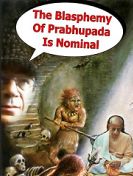
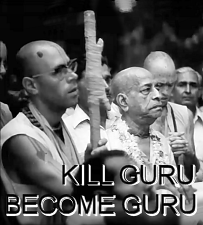
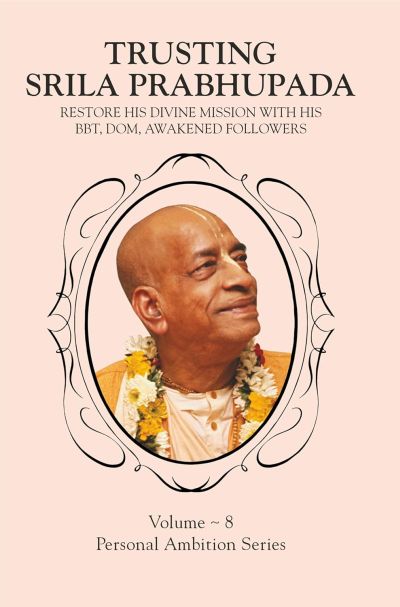
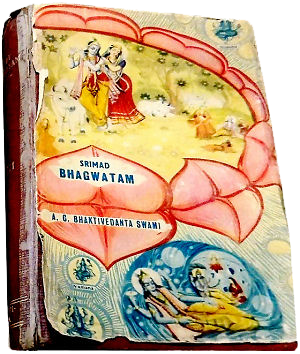
This article is pure nonsense, fiction and rubbish and I am at a loss to why such lies, deceit and bewilderment can ‘grace’ the pages of this website. This guy Satyanarayan has a student? This person must be the most unfortunate living entity on this planet! This is why Srila Bhaktisiddhanta Saraswati Thakur Prabhupada and Srila Bhaktivedanta Swami Prabhupada gave instructions to keep well away from these people as they are poison, deadly poison!
This is how they pollute everything, by offending The Goswami’s of our sampradaya so that they can keep association with low-class women and sponge money from gullible westerners.
Daso Smi
Sudarsana
Note: other so-called “diksa” gurus do NOT interest us. NOT PROMINENT ACARYA? Reject! Srila Prabhupada is the CURRENT DIKSA GURU PROMINENT ACARYA the evidence is: ALL are QUOTING Srila Prabhupada. Srila Prabhupada’s books,Temples,Mp3’s,disciples, are all over the planet, and he has stated VERY CLEARLY:WE HAVE TO PICK UP THE PROMINENT ACARYA, AND FOLLOW FROM HIM. Srila Prabhupada is THE Prominent Acarya we FOLLOW HIM. Srila Prabhupada set up the Ritvik system HIS ORDER we FOLLOW this – Bas!
If one has accepted one who is NOT PROMINENT Acarya as his “Diksa” guru then he is a CHEATER and he FOLLOWS a CHEATER. If one says his acarya is prominent then PROVE IT! What has he DONE in COMPARISON to Srila Prabhupada?
WE HAVE TO PICK UP THE PROMINENT ACARYA, AND FOLLOW FROM HIM.
68-04-12. Letter: Dayananda
Regarding parampara system: there is nothing to wonder for big gaps. Just like we belong to the Brahma Sampradaya, so we accept it from Krishna to Brahma, Brahma to Narada, Narada to Vyasadeva, Vyasadeva to Madhva, and between Vyasadeva and Madhva there is a big gap. But it is sometimes said that Vyasadeva is still living, and Madhva was fortunate enough to meet him directly. In a similar way, we find in the Bhagavad-gita that the Gita was taught to the sungod, some millions of years ago, but Krishna has mentioned only three names in this parampara system–namely, Vivasvan, Manu, and Iksvaku; and so these gaps do not hamper from understanding the parampara system. WE HAVE TO PICK UP THE PROMINENT ACARYA, AND FOLLOW FROM HIM. There are many branches also from the parampara system, and it is not possible to record all the branches and sub-branches in the disciplic succession. We have to pick up from the authority of the acharya in whatever sampradaya we belong to.
Srila Prabhupada IS Diksa Guru
http://www.prabhupadanugas.eu/news/?p=43094#more-43094
++++++++++++++++++++++++++++++++++++++++++++++++++++++++++++++++
Only Maha-Bhagavata is Diksa Guru
http://www.prabhupadanugas.eu/news/?p=41422#more-41422
+++++++++++++++++++++++++++++++++++++++++++++++++++++++++++++++
Srila Prabhupada THE ONLY CURRENT ETERNAL DIKSA GURU for ISKCON for AS LONG AS ISKCON EXISTS – NO COMPROMISE!
http://www.prabhupadanugas.eu/news/?p=44113#more-44113
I am perplexed by this post.
And I have a question – without any opinion of mine, implied or otherwise.
Your are posting this comprehensive and very knowledgeable article by Babaji Satyanarayana Das of Vrindavan (Jiva Institute). Does it mean that ‘prabhupadanuga.eu’ is endorsing what he is saying?
To the point of seeking his advice and reading the books published by him, such as the Sandarbhas by Srila Jiva Goswami? (Again, I am just asking.)
If so, I just can’t understand why you are posting Srila Prabhupada’s quotes in regard to Babajis of Vrindavan, since Babaji Satyanarayana Das is a Babaji of Vrindavan. And a very prominent and scholarly one.
Perhaps, I am missing something, but please clarify.
Satyanarayana Dasa: I am not against GM/ISKCON and I have great respect for Śrīla Prabhupāda.
Mahesh: SUPERFICIAL respect—- means nothing. REAL respect is ACCEPT Srila Prabhupada as YOUR Diksa guru and ACCEPT his Ritvik System as Ordered by him as per July 9th 1977.
Satyanarayana Dasa: I honor all Vaiṣṇavas although I am in knowledge of the philosophical problems of the GM and its branches. I have printed books in which I have acknowledged Śrīla Prabhupāda and in fact one of my books is dedicated to him. I also have thousands of recorded lectures which are available for anyone to verify this.
Mahesh: they all want to dedicate their books to Srila Prabhupada – how nice. Because—– WITHOUT mention of Srila Prabhupada, his photos etc their books have ZERO value—– and will NOT sell. Manipulation tactic to make some money, glorify oneself have own students(disciples) by USING Srila Prabhupada.
Aside from that Srila Prabhupada says: WE DON’T ALLOW ANY LITERATURE WHICH IS NOT GIVEN BY LIBERATED SOUL.
WE DON’T ALLOW ANY LITERATURE WHICH IS NOT GIVEN BY LIBERATED SOUL.
http://www.prabhupadanugas.eu/news/?p=41793#more-41793
http://www.harekrsna.com/sun/editorials/04-08/editorials2819.htm
http://bookchanges.com/prabhupada-worked-on-manuscript-with-hayagriva/
Satyanarayana Dasa: I tried to reconcile one of the differences I had with ISKCON in my book, “In Vaikuntha not even the Leaves Fall”, so that ISKCON’s teachings could be in line with the teachings of the Gosvamis, but this was not acceptable to the ISKCON leadership. As a result I was mistreated and my book was banned. Thus I saw no possibility of reconciliation, although that was my heart’s desire.
Mahesh: His “reconcile” AIM was HOW to be a WORD JUGGLER to DENY the FACT that ORIGIN of the soul is from Krishna lila:
http://harekrsna.com/sun/editorials/01-07/editorials1220.htm
http://www.harekrsna.com/sun/editorials/01-07/editorials1239.htm
730806BG.LON Lectures
And the human life… BECAUSE WE HAVE ALSO COME DOWN FROM VAIKUNTHA SOME MILLIONS AND MILLIONS OF YEARS AGO. ANADI KARAMA-PHALE. ANADI MEANS BEFORE THE CREATION.
Satyanarayana Dasa:Another allegation made by the author is that bābājīs are sahajiyās. When we use a word it has a specific meaning but here it is not clear what the word sahajiyā means for the author. The word sahajiyā is derived from the Sanskrit word sahaja which literally means born with or natural (saha + ja, saha = with, ja = born). The sahajiyā theory consists of two premises namely, (1) kṛṣṇa-prema is dormant in the heart and (2) this prema can be awakened by practicing love with a female partner. It should be also noted here that a practicing sahajiyā has only one female partner, not two or three.
Mahesh: we take the meaning of Sahajiya as given by Srila Prabhupada:
72-06-15. Letter: Himavati
Don’t try to do anything artificially. That is sahajiya, which means a class of men that take everything very cheap
Hare Krsna.
Unfortunately it is hard to reply to the author of this article. Because he does not know Srila Prabhupada’s books and teaching.So he will not understand the things. I experienced this also in connection with devotees of GM (Paramadvaiti). They love and accept Sridhara Maharaj and Srila Prabhupada SIMULTANEOUSLY!!! In spite of that they are thinking just like Sridhara Maharaj’s teaching. We can not help them because they should read Srila Prabhupada’s books. There is no other way to understanding! Because they will never see the difference.
I can tell Satyanarayana das only the same.
Satyanarayana Dasa says ;
” Here my Gurudeva’s name is mentioned incorrectly. His correct name is Nitya Smaraṇīya Śrī Śrī 108 Śrī Haridāsa Śāstrī Jī Mahārāja. The author asserts that the line of my guru and that of Śrī Paṇḍita Ananta Dāsa Bābājī of Rādhākuṇḍa fame are un-bonafide apasampradāyas. What is the basis of this? Does he have any proof? Obviously not. These two saintly people are the greatest living Vaiṣṇava scholar-saints of the Gauḍīya sampradāya. Both of them are highly renounced and impeccable in their character. I do not know anybody in the whole Gauḍīya Maṭha line who comes close to their scholarship and realization. ”
The answer is given by His Divine Grace Srila Prabhupada during the conversation which reads as ;
Prabhupāda: Yes. One has to come to that highest stage. It is not forbidden. That may be ideal, but not for the neophytes. You must…. One who does not know ABCD, what he will know about M.A. degrees? That they do not know. They think that they have already passed M.A. degree. That is their fault.
(morning walk Los_Angeles June 07, 1976) .
Where is the problem ?
In addition to my remarks, a further explanation to the particular statement of Satyanarayana Dasa which reads ;
” …… These two saintly people namely Nitya Smaraṇīya Śrī Śrī 108 Śrī Haridāsa Śāstrī Jī Mahārāja and Śrī Paṇḍita Ananta Dāsa Bābājī of Rādhākuṇḍa .are the greatest living Vaiṣṇava scholar-saints of the Gauḍīya sampradāya. Both of them are highly renounced and impeccable in their character. I do not know anybody in the whole Gauḍīya Maṭha line who comes close to their scholarship and realization. ”
( these two saintly people ) can be searched and verified through HDG. Srila Prabhupada’s VANI whether these two names as brought out by Satyanarayana Dasa are ever mentioned by Srila Prabhupada as a prominently bona fide or NOT.
If NOT, then, one should know and understand the different grades as in the Metals we find that there are Iron, Copper, Bronze, Silver, Gold and so on. No doubt these are all metals but different grades and quality which set them apart.
Therefore, Satyanarayana Dasa definitely needs to know and verify through the realized knowledge and its bonafide source who comes close to their scholarship and realization in the whole Gaudiya Matha line.
Hope it answers satisfactory.
Hare Krishna. All Glories to Srila Prabhupada.
As soon as this fellow makes the statement>>>
“It is clear that the general understanding within the Gauḍīya Maṭha (GM) and all of its branches like ISKCON”, we can understand where this person’s envious mind is at. For anyone to term Srila Prabhupada’s true ISKCON as a ‘branch’ of the Gaudiya Math is just plain offensive to His Divine Grace.
In Mahasrnga Prabhu’s article he quotes as follows
“Srila Prabhupada gave very firm instructions not to associate with any of the babajis of Vraja what to speak of Radhakunda. Here is a letter that he wrote to our god brother Nitai das, who Srila Prabhupada later kicked out of ISKCON for disobeying these instructions.
‘Please accept my blessings. I have received information that some of our devotees are mixing with the babajis in Vrindaban. This has produced so many problems amongst our men and women who visit Vrindaban. Here in Los Angeles, we have found that there is a group of about 40 devotees who privately meet to discuss the intimate pastimes artificially thinking that they can enter into the understanding of the gopis prematurely. This will create havoc in our society, and the result will be that if this is allowed to go on, our preaching work will be greatly hampered. This premature desire to understand the lila of Krishna is due to mundane sex-life desire as we have seen amongst many of the babajis and sahajiyas in Vrindaban. Our Jagannatha das came back from Vrindaban asking me that he had heard some babaji speaking about siddha-deha and he also was listening to these babajis. So I want this immediately stopped. If it continues, this mixing with the babajis, then it will mean spoiling. In many cases, these babajis keep 2 or 3 women. Asatsanga tyagi. Their association is to be avoided and prohibited amongst all of our devotees who visit Vrindaban. A.C. Bhaktivedanta Swami’
(Letter to: Nitāi, June 7, 1976, Los Angeles) ”
I am also wondering why this dribble, so opposed to the teachings & instructions of our Srila Prabhupada and also Srila Bhaktisiddhanta and Srila Bhaktivinode Thakur, is given any ‘air-time’ on this Prabhupadanuga Forum!
Yhs,
Balaram das.